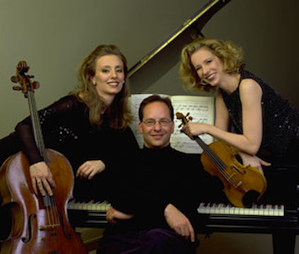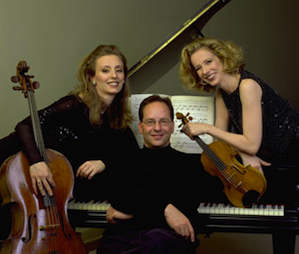
Music at Kohl Mansion in Burlingame presented Trio Solisti in a Sunday program that was essentially one giant crescendo. It started off with very early (1792, Bonn) Beethoven variations, grew in intensity with an 1881 trio by Ernest Chausson, and culminated in an original arrangement of Modest Mussorgsky’s Pictures at an Exhibition.
The Beethoven Op. 44 variations (given an advanced number because they were published only in 1804) begin with highly exposed, transparent writing. The entire ensemble plays arpeggios in soft unison — the simplest way to start. As the voices branch out, violinist Maria Bachmann and cellist Alexis Pia Gerlach were able to play with an incredibly quiet sound that still managed to “speak.” And the intimate acoustics of the Kohl Mansion allowed them to explore truly hushed tones.
Bachmann, in particular, gets a very sweet sound on her violin, even in the pianissimo range. Her flexible bow wrist enabled her to pull amazing colors out of the instrument. Her intonation and rhythmic accuracy were miraculous. Gerlach plays the cello with a lot of love; she breathes through the music, has a gorgeous vibrato, and milks expression out of every melodic interval she plays. For the fragile Beethoven introduction, however, all this may have been a bit big — some of the delicate phrases seemed smothered with too much attention. For the Chausson and Mussorgsky, though, it was perfect.
Before this concert, I had of course been aware of the French composer Ernest Chausson but didn’t feel enthusiastic about him. After hearing Solisti’s impassioned case for his music, I am now a fan of his. French Romantic music is sometimes played with emotions held in check, concentrating on colors instead. Trio Solisti held nothing back. They employed the full dynamic and emotional breadth provided by the composer. This piece had everything: a heavily brooding first movement, a fleeting second movement scherzo, a tragic slow movement, and a fast finale that was stomped out by an even more emphatic return of music from the first movement. It was a perfect example of the late-Romantic formula for a mature chamber work, on par with those by Brahms and Dvořák.
Bachmann gets a very sweet sound on her violin. …Gerlach plays the cello with a lot of love. … Klibonoff completed the ensemble with formidable playing.
Chausson goes even one step further with the use of oriental-flavored modes and extended unison lines that German composers probably could not sustain without breaking into more-complex counterpoint. I thank Trio Solisti for stepping off the beaten path and programming this wonderful piece, and for truly tackling it head-on and believing in its over-the-top gestures. For example, the echoes in the piano at the end of the first movement, interrupted by aggressive hits, would have sounded contrived had they not been played with such strong belief and courage.
The trio then went even further afield (for a chamber ensemble, that is) with an original arrangement of Mussorgsky’s Pictures. Bachman’s handwritten part, covered in scribbles and red pencil marks, was a visible testament to the intense wrestling that must have gone on in the creation and rehearsal process. When an ensemble plays something that it had to toil for, the performance benefits tremendously. At first, I was missing the brass sound from the familiar Ravel orchestral version. The piece sounded self-consciously like an arrangement, rather than the original thing. But pretty soon my ears grew accustomed to the trio sound in it, and by the second or third “picture” I decided that I like the trio version even better.
The trio plays together with natural familiarity and an easily combustible chemistry.
In the orchestra, passing lines around to various instruments dilutes the details. Fast-note passages get obscured when played by an entire section. Sometimes the personal immediacy of chamber music provides even more intensity than a full symphony orchestra. Apparently there are as many as 600 versions of this piece catalogued by the dedicated Pictures at an Exhibition Society. There are even other piano trio versions available. So why, I wonder, make yet another version? Because, I concluded, there’s nothing like having your own unique rendition, designed to suit each player’s individual strengths.
It was easy to let the ladies, in their fabulous dresses and theatrical gestures, steal Sunday’s show, but pianist Jon Klibonoff completed the ensemble with formidable playing. He was both the anchor and the ocean waves, while the violin and cello were boats tossed by a storm. He saved the extremely loud sound of the Steinway for the very end of the concert. Just when I thought it couldn’t get any more intense, the Trio pulled out another level of passion, surpassing everything that came before. Tremolos eclipsed trills, and fingered octaves in the high registers outdid everything else, to produce a rousing climax at the very end. The trio plays together with natural familiarity and an easily combustible chemistry that comes from playing together for a decade. I hope they return to the Bay Area soon.

